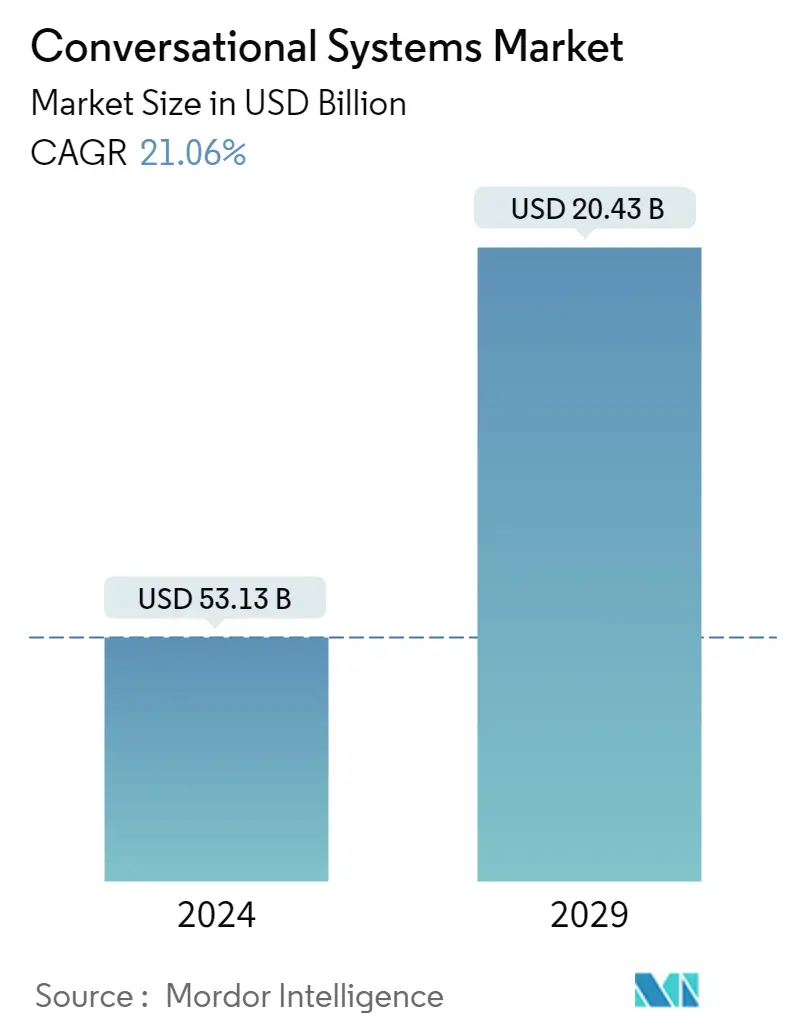Market Size of Conversational Systems Industry

| Study Period | 2019 - 2029 |
| Market Size (2024) | USD 53.13 Billion |
| Market Size (2029) | USD 20.43 Billion |
| CAGR (2024 - 2029) | 21.06 % |
| Fastest Growing Market | Asia Pacific |
| Largest Market | North America |
Major Players
*Disclaimer: Major Players sorted in no particular order |
Conversational AI Market Analysis
The Conversational Systems Market size is estimated at USD 53.13 billion in 2024, and is expected to reach USD 20.43 billion by 2029, growing at a CAGR of 21.06% during the forecast period (2024-2029).
Conversational AI systems are intelligent machine solutions that understand language and conduct verbal or written customer conversations. These systems are aimed at improving the customer experience by boosting interaction.
- The availability of large amounts of data and increasing data-related complexities in enterprises are expected to drive the market demand for conversational system solutions. Further, the requirement of artificial intelligence (AI)-)-enabled systems to mimic human brains is one of the crucial parameters responsible for the development of the industry.
- The usage of conversational systems is increasing because of deep neural networks, machine learning, and other advancements in AI technologies. Conversational systems like chatbots are used for various applications across several end-user verticals. One primary consumer-facing application is a conversational system that acts as a personal assistant. It helps consumers accomplish various tasks; for instance, Apple's Siri offers an intuitive interface for connected homes or cars.
- An organization can simplify and reimagine business processes through conversational software platforms and reduce and automate business workflows through context-aware intelligence systems. These platforms enable users and systems to have meaningful interactions and work in tandem to meet business objectives.
- Furthermore, integrating artificial intelligence (AI) capabilities with conversational systems provides significant opportunities for growth in the global conversational systems market. Various factors, such as a lack of understanding of developing technologies and these systems' dependency on deployment platforms, are projected to hinder market expansion. Additionally, a lack of accuracy in virtual assistants and chatbots is expected to limit the market growth.
- However, the pandemic has bolstered the rapid adoption of advanced technologies. Further, to ease the several processes, various startups have been launched, and new solutions are also coming up, thereby contributing to the market growth rate. For instance, in December 2023, Instabase introduced its conversational AI for cross-document reasoning feature, which allows users to ask natural language questions across multiple documents and quickly receive accurate answers in Converse without any coding or data science expertise.
Conversational AI Industry Segmentation
A conversational AI technology processes and converts simple bidirectional text and conversation into meaningful output. Traditional systems are sophisticated instruments equipped with sensors, IoT systems, and appliances. These systems use enhanced methods of communication, such as sight, sound, and tactile, to communicate across a digital device network.
The conversational AI market is segmented by modality type (uni-modal and multi-modal), by type (voice-assisted and text-assisted), by deployment (on-premise, cloud), by enterprise size (small & medium enterprises, large enterprises), by end-user verticals (IT & telecommunication, BFSI, government, retail, energy & power, and other end-users), and geography (North America, Middle East and Africa, Latin America, Asia Pacific, and Europe). The market sizes and forecasts are provided in terms of value in (USD) for all the above segments.
| By Modality Type | |
| Uni-Modal | |
| Multi-Modal |
| By Type | |
| Voice Assisted | |
| Text Assisted | |
| Other Types |
| By Deployment | |
| On-Premise | |
| Cloud |
| By Enterprise Size | |
| Small & Medium Enterprises | |
| Large Enterprises |
| By End-user Verticals | |
| IT & Telecommunication | |
| BFSI | |
| Government | |
| Retail | |
| Energy & Power | |
| Other End-User Verticals (Educational Institutions, Travel & Tourism, Transportation & Logistics) |
| By Geography*** | |
| North America | |
| Europe | |
| Asia | |
| Australia and New Zealand | |
| Latin America | |
| Middle East and Africa |
Conversational Systems Market Size Summary
The conversational systems market is poised for significant growth, driven by advancements in artificial intelligence and natural language processing technologies. These intelligent machine solutions, which facilitate verbal and written interactions, are increasingly being adopted across various industries to enhance customer experiences and streamline business processes. The integration of AI capabilities with conversational systems presents substantial growth opportunities, as these systems are capable of automating and improving customer support services, thereby boosting loyalty, brand reputation, and revenue. Despite challenges such as technological complexities and accuracy issues, the market is expected to expand, with the COVID-19 pandemic acting as a catalyst for increased adoption, particularly in contact centers.
Regionally, the Asia-Pacific market is experiencing rapid growth due to the presence of technology providers and the rising demand for advanced bot solutions in sectors like retail and e-commerce. The pandemic further accelerated the deployment of conversational systems in this region, as organizations sought to manage increased customer inquiries effectively. Major players in the market, including IBM, Microsoft, Google, and Amazon Web Services, are actively enhancing their offerings through strategic partnerships and acquisitions. These efforts aim to leverage AI and NLP advancements to provide superior digital experiences. The market's fragmented nature and the ongoing technological advancements suggest a competitive landscape with continuous innovation and expansion.
Conversational Systems Market Size - Table of Contents
-
1. MARKET INSIGHTS
-
1.1 Market Overview
-
1.2 Industry Attractiveness - Porter's Five Forces Analysis
-
1.2.1 Threat of New Entrants
-
1.2.2 Bargaining Power of Buyers/Consumers
-
1.2.3 Bargaining Power of Suppliers
-
1.2.4 Threat of Substitute Products and Services
-
1.2.5 Intensity of Competitive Rivalry
-
-
1.3 Impact of Macroeconomic Trends on the Market
-
-
2. MARKET SEGMENTATION
-
2.1 By Modality Type
-
2.1.1 Uni-Modal
-
2.1.2 Multi-Modal
-
-
2.2 By Type
-
2.2.1 Voice Assisted
-
2.2.2 Text Assisted
-
2.2.3 Other Types
-
-
2.3 By Deployment
-
2.3.1 On-Premise
-
2.3.2 Cloud
-
-
2.4 By Enterprise Size
-
2.4.1 Small & Medium Enterprises
-
2.4.2 Large Enterprises
-
-
2.5 By End-user Verticals
-
2.5.1 IT & Telecommunication
-
2.5.2 BFSI
-
2.5.3 Government
-
2.5.4 Retail
-
2.5.5 Energy & Power
-
2.5.6 Other End-User Verticals (Educational Institutions, Travel & Tourism, Transportation & Logistics)
-
-
2.6 By Geography***
-
2.6.1 North America
-
2.6.2 Europe
-
2.6.3 Asia
-
2.6.4 Australia and New Zealand
-
2.6.5 Latin America
-
2.6.6 Middle East and Africa
-
-
Conversational Systems Market Size FAQs
How big is the Conversational Systems Market?
The Conversational Systems Market size is expected to reach USD 53.13 billion in 2024 and grow at a CAGR of 21.06% to reach USD 20.43 billion by 2029.
What is the current Conversational Systems Market size?
In 2024, the Conversational Systems Market size is expected to reach USD 53.13 billion.

